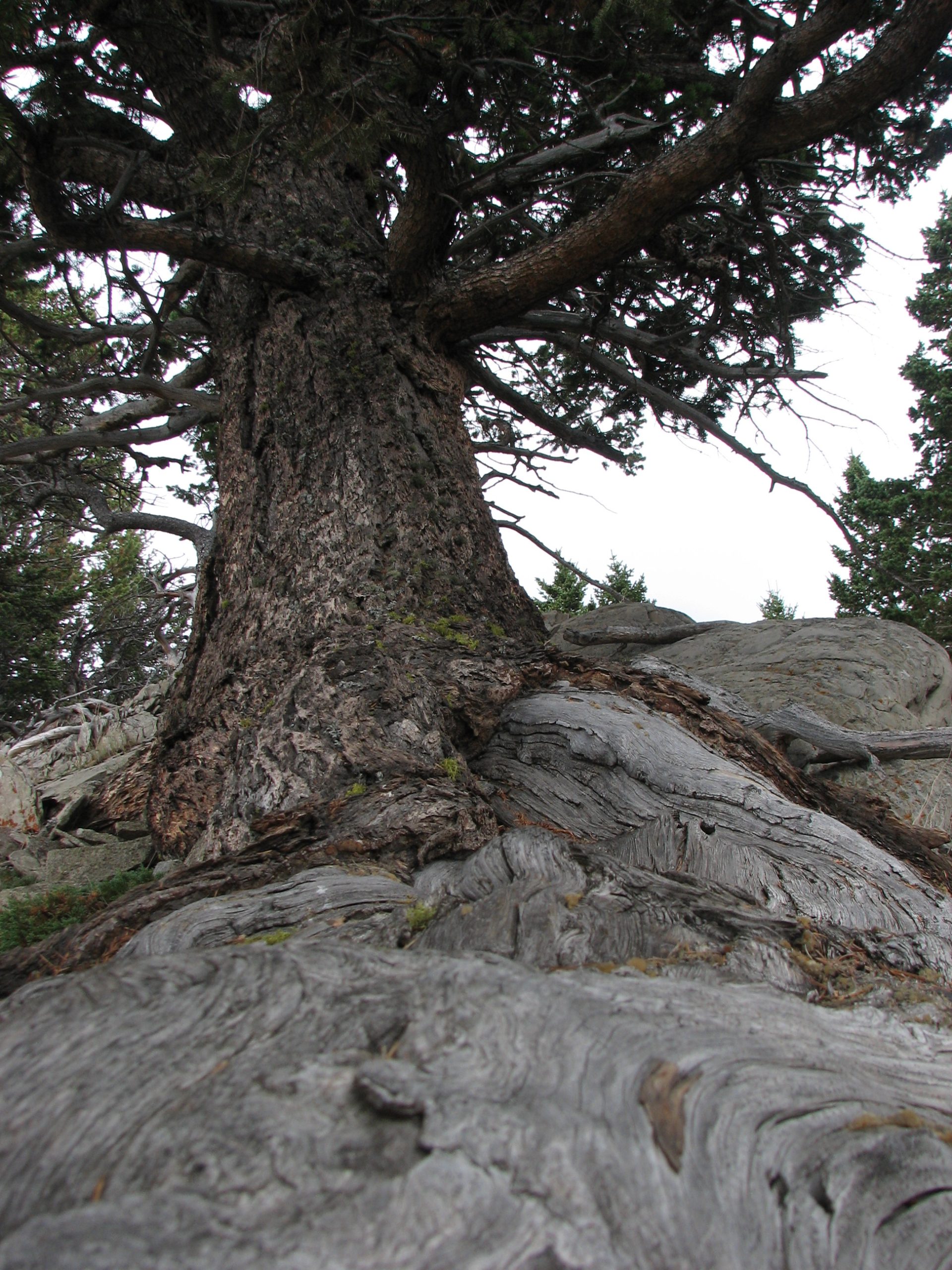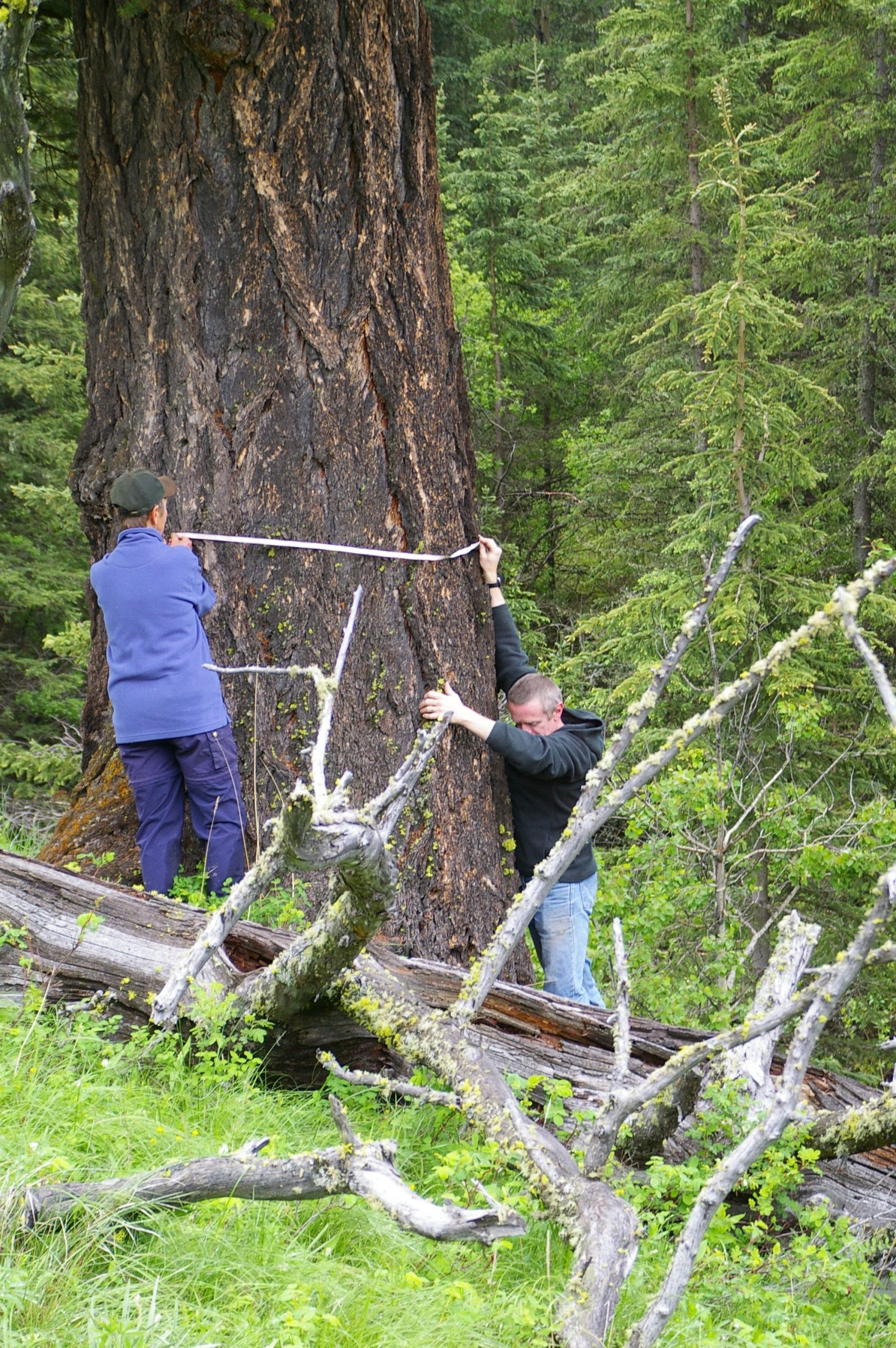
Of Tree Rings and Tea Leaves: What the Trees Have Told Us
August 2, 2024
- •
- •
- •
It might not be common knowledge in today’s world, but these old trees can talk.
By Lorne Fitch
Read the PDF version here.
Towering above a windswept ridge in the Porcupine Hills of southern Alberta is an ancient, gnarled Douglas fir. Its circumference is measured with multiple tree huggers. A lightning scar runs down the thick trunk to protruding roots, some bigger than your thigh. Some of its branches are larger than the trunks of lodgepole pine trees further down the slope.
If you think the tree has been there forever, you are mostly right.
It might not be common knowledge in today’s world, but these old trees can talk. In each layer of their trunk, they hold ancient wisdom acquired with centuries of life experience. Dr. David Sauchyn has been tuning in.
David, who is the director of the Prairie Adaptation Research Collaborative at the University of Regina, alongside his colleagues and students, has scoured the ridges of southwestern Alberta for the past couple of decades looking for these old trees to see what’s inside.
A tree grows in diameter with cell divisions in the cambium layer of the bark. Annual growth increments show up as concentric rings, with the earliest at the centre of the trunk and the newest additions just under the bark. A cross-sectional profile of a tree shows not just its age, but how it prospered and faltered during its life.
Using specialized tools known as increment borers, David’s team extracted sections of wood from the trunks. The tools allow researchers to count and assess the growth rings in the core sample. Use of the tool is heavy work. Augering through a metre or more of tree trunk and hitting the centre is a job for patient people. Slowly, the team uncovered pieces of history, as told by the trees. The older the tree, the longer the snapshot in time.
What the growth rings from many old trees provide, is a very large, long snapshot of time. The growth increments are a measure of the year they were lain down, especially what moisture was available. Mark Twain famously said, “Climate is what we expect, weather is what we get.” A tree ring is a measure of the conditions for that year while the growth increments over time tell us about climate and how it changed.
Using the growth ring data from 196 trees of two long-lived species, limber pine and Douglas fir, researchers from the University of Regina have been able to extrapolate the changing conditions of moisture and construct 900 years of streamflow information. The practice — known as dendrohydrology — can help predict future conditions and how to prepare for climate extremes, like drought and flood, perhaps occurring simultaneously.
Reading between the rings
There are many nuggets in the dozens of research reports on what old trees told us. Although couched in the turgid language of research, interpretation of the science should make us pause and reflect.
Foremost is the reminder we live in a land of recurring drought, which introduces substantial risk. This is immediately so for the South Saskatchewan River Basin, one of Canada’s most threatened watersheds, with water supplies in most subbasins overallocated.
Results from David’s team indicate that the drought characteristics over the past millennium have differed substantially from those over the past century. The infamous drought of the 1930s looks like a minor wet period in comparison to the recurring drought of the 1500s.
Yet, we’re planning our future endeavours in Alberta based on limited information. It’s as fraught with risk as our recent history. John Palliser’s expedition in the mid-1850s found the prairies were very dry, leading to the slightly ill-defined “Palliser’s Triangle” and the sense this was a landscape not suitable for settlement. Less than two decades later, John Macoun reported on abundant moisture conditions and championed the farming capability of the prairies, leading to the settlement patterns of today.
Each had seen only one part of the climate elephant. For the federal government and the Canadian Pacific Railway Palliser’s observations were viewed as an aberration and ignored. Generations of farmers would subsequently live with the enduring frustration of recurring drought.
Using historical data from the last 100 years alone to define how to respond to drought could seriously underestimate its potential severity. We could be led down a path of building more storage reservoirs, without enough water to fill them. The results from analyzing tree rings indicate that the severity and duration of hydrological droughts with the same recurrence interval is substantially larger and longer than those observed in 100 years of settler historical records.
An octogenarian human would be viewed by an ancient tree as a stripling, without enough experience to warrant any attention. In that vein, researchers commented that “it is irrational to assume stationary climate in determining the frequency of severe droughts.” This is where the paleo record provides such valuable insights.
Rapid population growth, economic development (especially irrigation agriculture and food processing) and climate change have exposed this region to increasing vulnerability to drought. This is especially so since longer periods of low flows have occurred in our paleo-past than have been recorded in historical records.
An Old Tree’s Advice
Diminishing streamflow from the Eastern Slopes, coupled with drought risk and high demand for surface water means there will not be enough to sustain our expectations for economic growth. Given those expectations, we are set to sacrifice aquatic health, riparian areas and biodiversity.
Old trees have given us a gift of insight into climate and extreme variability, especially on the drought side. It’s a cautionary tale about our future. Those ancient ones survived and might help us recognize the limits applied to a landscape of variable precipitation. “Adapt,” they might say, if we could listen, “and don’t think tomorrow is just a continuation of today.”
Without looking back, way back, we can be fooled badly, lulled into complacency about the future. A rancher friend, with tongue in cheek, reminded me, “It always rains right after a drought.” Some actually cling to that, but hope isn’t a strategy, it’s a capitulation to inaction and sometimes the wrong actions in the face of evidence.
The story of old trees gives us better goal posts than hope does. We have additional issues to confront. A pervasive one is the rate that our actions, especially the liberation of greenhouse gases from the burning of fossil fuels, is exacerbating change in the climate.
Do we have the tenacity to weather years of drought combined with wicked storms and floods, all driven by climate change? Can we afford the insurance premiums for crops and our property in the face of drought, flood and wildfire? Will banks continue to provide operating loans? Can we continue to push the envelope for irrigation, for urban expansion, for other water-thirsty economic endeavours and for logging the headwaters’ source of our water?
All these encroach on and exceed ecological lines in the sand. Viewing tomorrow as just across another line in the sand doesn’t strike me as a survival strategy. It seems self-destructive.
Old trees have imparted some wisdom, some reflection, maybe some advice to consider about our future. We should listen, reflect on the tea leaves provided and reconcile that we can, we must do better and be smarter to prepare for the changes our climate will deliver.
Clinging to ridges with roots deep into cracks and crevices in the bedrock, ancient trees are the personification of patience and persistence. Their survival adaptations have been ones of hunkering down, not competing for scarce resources, enduring the bad times, when water was mostly unavailable and not expanding much when conditions were favourable.
It would have been uncharacteristic of old trees to push down hard on the accelerator of growth at their own expense. Old trees recognized limits and lived within them. That strategy has allowed them to survive for centuries.
Lorne Fitch is a Professional Biologist, a retired Fish and Wildlife Biologist and a past Adjunct Professor with the University of Calgary.

